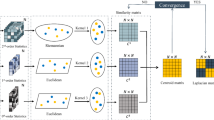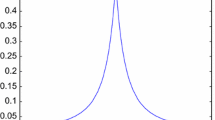Abstract
Considering that the conventional subspace clustering methods of sparse subspace clustering (SSC) and low-rank representation (LRR) are only applicable to linear manifolds, we propose a novel subspace clustering framework that generalizes them for nonlinear manifolds. To do this, we integrate a weighting matrix and kernel matrix into the regularization of this framework. The weighting matrix is calculated using the similarities between tangent spaces on data manifolds and the Euclidean distances between data points, so that it can explicitly characterize the intrinsic geometry of data manifolds. Besides, we provide a geometrical interpretation for the effects of weighted ℓ∗-norm involved in the proposed framework, exploiting symmetric gauge function (SGF) of von Neumann theory that establishes a relationship exactly between singular and matrix norm. To solve the regularization with respect to the weighted norm, we design a fixed-point continuation algorithm to obtain an approximate closed solution. Experimental results on three computer vision tasks show the superiority of clustering accuracy over other similar approaches and demonstrate the effectiveness of the weighting matrix. That also proves the proposed method has better interpretability than other state-of-the-art methods.



Similar content being viewed by others
References
Bai L, Liang J (2020) Sparse subspace clustering with entropy-norm. In: International conference on machine learning, pp 561–568. PMLR
Basri R, Jacobs DW (2003) Lambertian reflectance and linear subspaces. IEEE Trans Pattern Anal Mach Intell 2:218–233
Bishop CM (2006) Pattern recognition. Mach Learn, 128(9)
Boyd S, Parikh N, Chu E, Peleato B, Eckstein J, et al. (2011) Distributed optimization and statistical learning via the alternating direction method of multipliers. Found and Trends®;, Mach Learn 3 (1):1–122
Cai JF, Candès EJ, Shen Z (2010) A singular value thresholding algorithm for matrix completion. SIAM J Optim 20(4):1956–1982
Candes EJ, Wakin MB, Boyd SP (2008) Enhancing sparsity by reweighted l1 minimization. J Fourier Anal Applic 14(5–6):877–905
Chen Y, Li CG, You C (2020) Stochastic sparse subspace clustering. In: Proceedings of the IEEE/CVF conference on computer vision and pattern recognition, pp 4155–4164
Chen Y, Li G, Gu Y (2017) Active orthogonal matching pursuit for sparse subspace clustering. IEEE Signal Process Lett 25(2):164–168
Chun-Guang Li, Chong Y, René V (2017) Structured sparse subspace clustering: a joint affinity learning and subspace clustering framework. IEEE Transactions on Image Processing
Elhamifar E, Vidal R (2009) Sparse subspace clustering. In: 2009 IEEE Conference on computer vision and pattern recognition, pp 2790–2797. IEEE
Elhamifar E, Vidal R (2013) Sparse subspace clustering: algorithm, theory, and applications. IEEE Trans Pattern Anal Mach Intell 35(11):2765–2781
Goh A, Vidal R (2008) Clustering and dimensionality reduction on riemannian manifolds. In: 2008 IEEE Conference on computer vision and pattern recognition, pp 1–7. IEEE
Goldfarb D, Ma S (2011) Convergence of fixed-point continuation algorithms for matrix rank minimization. Found Comput Math 11(2):183–210
Gu S, Zhang L, Zuo W, Feng X (2014) Weighted nuclear norm minimization with application to image denoising. In: Proceedings of the IEEE conference on computer vision and pattern recognition, pp 2862–2869
Hale ET, Yin W, Zhang Y (2008) Fixed-point continuation for l1-minimization: methodology and convergence. SIAM J Optim 19(3):1107–1130
Harandi MT, Hartley R, Lovell B, Sanderson C (2015) Sparse coding on symmetric positive definite manifolds using Bregman divergences. IEEE Trans Neural Netw Learn Syst 27(6):1294–1306
Ji P, Zhang T, Li H, Salzmann M, Reid I (2017) Deep subspace clustering networks. In: Neural information processing systems (NIPS), CONF
Kheirandishfard M, Zohrizadeh F, Kamangar F (2020) Deep low-rank subspace clustering. In: Proceedings of the IEEE/CVF conference on computer vision and pattern recognition workshops, pp 864–865
Lee KC, Ho J, Kriegman DJ (2005) Acquiring linear subspaces for face recognition under variable lighting. IEEE Trans Pattern Anal Mach Intell 5:684–698
Lewis AS (2003) The mathematics of eigenvalue optimization. Math Program 97(1–2):155–176
Lin Z, Chen M, Ma Y (2010) The augmented lagrange multiplier method for exact recovery of corrupted low-rank matrices, arXiv:1009.50551009.5055
Liu G, Lin Z, Yan S, Sun J, Yu Y, Ma Y (2012) Robust recovery of subspace structures by low-rank representation. IEEE Trans Pattern Anal Mach Intell 35(1):171–184
Liu J, Han J (2018) Spectral clustering. In: Data clustering, pp 177–200. Chapman and Hall/CRC
Lu C, Feng J, Lin Z, Mei T, Yan S (2018) Subspace clustering by block diagonal representation. IEEE Trans Pattern Anal Machine Intell 41(2):487–501
Nguyen H, Yang W, Shen F, Sun C (2015) Kernel low-rank representation for face recognition. Neurocomputing 155:32–42
Patel VM, Van Nguyen H, Vidal R (2013) Latent space sparse subspace clustering. In: Proceedings of the IEEE international conference on computer vision, pp 225–232
Patel VM, Vidal R (2014) Kernel sparse subspace clustering. In: 2014 IEEE international conference on image processing (ICIP), pp 2849–2853. IEEE
Peng X, Feng J, Zhou J, Lei Y, Yan S (2020) Deep subspace clustering. IEEE Trans Neural Netw Learn Syst 31(12):5509–5521
Pham DS, Budhaditya S, Phung D, Venkatesh S (2012) Improved subspace clustering via exploitation of spatial constraints. In: 2012 IEEE Conference on computer vision and pattern recognition, pp 550–557. IEEE
Roweis ST, Saul LK (2000) . Nonlinear dimensionality reduction by locally linear embedding science 290(5500):2323–2326
Soltanolkotabi M, Candes EJ, et al. (2012) A geometric analysis of subspace clustering with outliers. Ann Stat 40(4):2195–2238
Somandepalli K, Narayanan S (2019) Reinforcing self-expressive representation with constraint propagation for face clustering in movies. In: ICASSP 2019-2019 IEEE International conference on acoustics, speech and signal processing (ICASSP), pp 4065–4069. IEEE
Tenenbaum JB, De Silva V, Langford JC (2000) . A global geometric framework for nonlinear dimensionality reduction. Science 290(5500):2319–2323
Tomasi C, Kanade T (1992) Shape and motion from image streams under orthography: a factorization method. Int J Comput Vis 9(2):137–154
Tron R, Vidal R (2007) A benchmark for the comparison of 3-d motion segmentation algorithms. In: 2007 IEEE conference on computer vision and pattern recognition, pp 1–8. IEEE
Vidal R (2011) Subspace clustering. IEEE Signal Process Mag 28 (2):52–68
Vidal R, Favaro P (2014) Low rank subspace clustering (lrsc). Pattern Recogn Lett 43:47–61
Von Neumann J (1937) Some matrix-inequalities and metrization of matric space
Wang P, Han B, Li J, Gao X (2019) Structural reweight sparse subspace clustering. Neural Process Lett 49(3):965–977
Wang Y, Jiang Y, Wu Y, Zhou ZH (2011) Spectral clustering on multiple manifolds. IEEE Trans Neural Netw 22(7):1149–1161
Wang Y, Wang YX, Singh A (2018) A theoretical analysis of noisy sparse subspace clustering on dimensionality-reduced data. IEEE Trans Inf Theory 65(2):685–706
Watson GA (1992) Characterization of the subdifferential of some matrix norms. Linear Algebra Applic 170:33–45
Wu JY, Huang LC, Yang MH, Chang LH, Liu CH (2019) Sparse subspace clustering with sequentially ordered and weighted l1-minimization. In: 2019 IEEE International conference on image processing (ICIP), pp 3387–3391. IEEE
Xia G, Sun H, Feng L, Zhang G, Liu Y (2017) Human motion segmentation via robust kernel sparse subspace clustering. IEEE Trans Image Process 27(1):135–150
Xiao S, Tan M, Xu D, Dong ZY (2015) Robust kernel low-rank representation. IEEE Trans Neur Netw Learn Syst 27(11):2268–2281
Yang C, Ren Z, Sun Q, Wu M, Yin M, Sun Y (2019) Joint correntropy metric weighting and block diagonal regularizer for robust multiple kernel subspace clustering. Inform Sci 500:48–66
Yin M, Guo Y, Gao J, He Z, Xie S (2016) Kernel sparse subspace clustering on symmetric positive definite manifolds. In: Proceedings of the IEEE conference on computer vision and pattern recognition, pp 5157–5164
You C, Robinson D, Vidal R (2016) Scalable sparse subspace clustering by orthogonal matching pursuit. In: Proceedings of the IEEE conference on computer vision and pattern recognition, pp 3918–3927
You C, Vidal R (2015) Geometric conditions for subspace-sparse recovery. In: International conference on machine learning, pp 1585–1593. PMLR
Zhai H, Zhang H, Zhang L, Li P, Plaza A (2016) A new sparse subspace clustering algorithm for hyperspectral remote sensing imagery. IEEE Geosci Remote Sens Lett 14(1):43–47
Zhan J, Zhu Y, Bai Z (2020) An expression-reinforced sparse subspace clustering by orthogonal matching pursuit. In: 2020 IEEE International conference on image processing (ICIP), pp 211–215. IEEE
Zhang J, Li CG, You C, Qi X, Zhang H, Guo J, Lin Z (2019) Self-supervised convolutional subspace clustering network. In: Proceedings of the IEEE/CVF conference on computer vision and pattern recognition, pp 5473–5482
Zhang Q, Wu YN, Zhu SC (2017) Interpretable convolutional neural networks. In: 2018 IEEE/CVF conference on computer vision and pattern recognition
Zhang T, Yang J, Zhao D, Ge X (2007) Linear local tangent space alignment and application to face recognition. Neurocomputing 70(7-9):1547–1553
Zhou L, Xiao B, Liu X, Zhou J, Hancock ER, et al. (2019) Latent distribution preserving deep subspace clustering. In: 28th International joint conference on artificial intelligence, pp 4440–4446. York
Zhou P, Hou Y, Feng J (2018) Deep adversarial subspace clustering. In: Proceedings of the IEEE conference on computer vision and pattern recognition, pp 1596–1604
Zhu W, Peng B (2020) Sparse and low-rank regularized deep subspace clustering. Knowl-Based Syst 204:106199
Author information
Authors and Affiliations
Corresponding author
Ethics declarations
Conflict of Interests
The authors declare that they have no conflict of interest.
Additional information
Publisher’s note
Springer Nature remains neutral with regard to jurisdictional claims in published maps and institutional affiliations.
Rights and permissions
About this article
Cite this article
Liu, S., Wang, H. Geometric weighting subspace clustering on nonlinear manifolds. Multimed Tools Appl 81, 42971–42990 (2022). https://doi.org/10.1007/s11042-022-12797-0
Received:
Revised:
Accepted:
Published:
Issue Date:
DOI: https://doi.org/10.1007/s11042-022-12797-0




